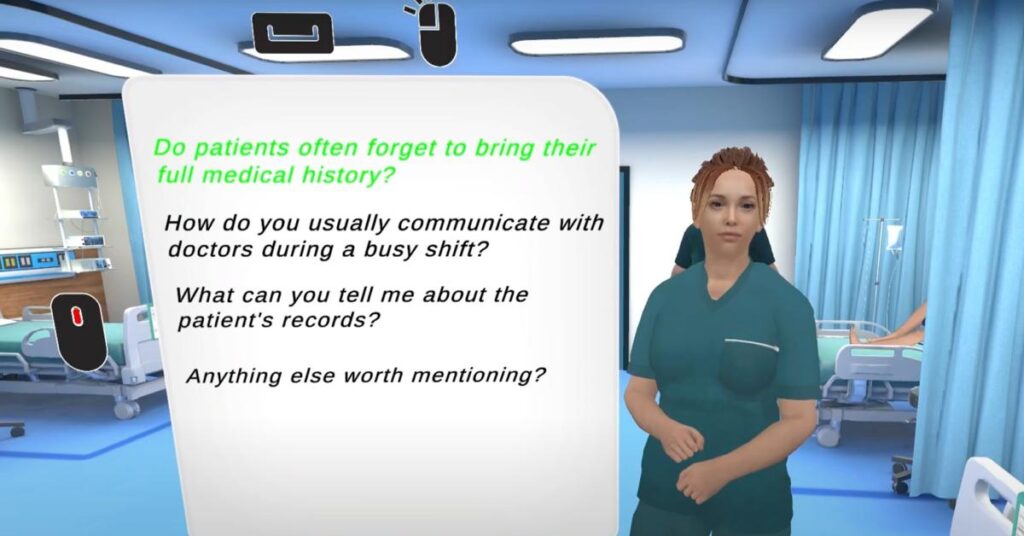-
H-Pass > Blog > Uncategorized > The Power of VR in Shaping the Future of Medical Education”
The Power of VR in Shaping the Future of Medical Education”

Virtual Reality (VR) is shaking up the world of healthcare education, offering an innovative, immersive approach to training that’s more engaging, safer, and, ultimately, more effective. The H-PASS VR prototype marks a significant step forward in this revolution, blending the latest technology with practical, real-world application.
Why VR is a Game-Changer in Healthcare Training
Training healthcare professionals in a safe, controlled environment is a must, but traditional methods simply don’t offer the immersive, hands-on experience that modern healthcare demands. VR does exactly that—and then some. Here’s how:
1. Risk-Free Learning
VR offers the opportunity to practice high-risk, delicate procedures without the danger of causing harm to real patients. Medical errors can be costly, but with VR, learners can make mistakes, learn, and repeat until they’ve mastered the skills.
2. Immersive Training Experiences
Imagine a clinical scenario where every detail—from the sound of the heart monitor to the hospital’s ambient noise—feels real. VR can bring that to life. The result? Deeply engaged learners who remember more because they’ve experienced it firsthand, not just read about it.
3. Repetition at Scale
One of the most exciting aspects of VR is the ability to practice over and over again, honing skills until they are second nature. In traditional settings, this isn’t always possible due to time and resource constraints, but VR offers unlimited deliberate practice to achieve true competence.
4. Cost-Effective Training
Traditional methods often involve expensive mannequins, specialized equipment, and dedicated training centers. VR cuts out these costs while providing a high-quality, repeatable learning experience that’s easily scalable and cost-efficient over time.
5. Accessible, Standardized Training
With VR, training becomes consistent, regardless of where it’s being delivered. Whether you’re in a state-of-the-art hospital or a remote region, VR provides equal access to high-quality training. No matter the geographical constraints, everyone gets the same level of immersive education.
6. Actionable Feedback
VR environments track performance in real time, offering objective feedback that helps learners identify areas for improvement. This data-driven approach makes training more personalized, empowering professionals to refine their skills and advance their expertise faster.
Behind the Scenes: Building the VR Training Prototype
Creating an effective VR training tool isn’t just about fancy tech. It’s about crafting an experience that’s both realistic and functional for healthcare professionals. Here’s a peek into how we built it:
1. Research and Development
Extensive research went into developing a 3D environment accessible via both VR headsets and standard web browsers. Balancing the visual quality and ensuring smooth performance on different hardware setups posed a unique challenge—but overcoming it opened up a world of possibilities.
2. Innovation in Optimization
VR experiences can be demanding on hardware. To make sure the experience was seamless for all users, we optimized the platform without compromising on realism. We integrated dynamic sounds, visual effects, and interactive scenarios while making sure the system performed well on diverse user devices.
3. Realism Meets Practicality
Realism was key—imagine realistic hospital settings, constant background noise, and non-player characters going about their tasks. Yet, we had to balance that with hardware limitations to ensure the system worked effectively for users across all platforms.
4. Browser-Based Accessibility
One of the biggest breakthroughs in this project was making the VR environment accessible through web browsers without the need to install extra software. This easy accessibility ensures that anyone with a PC or VR headset can access the training anytime, anywhere.
What Does This Mean for Healthcare Training?
This VR prototype isn’t just a cool tool—it’s a game-changer for healthcare training. The result is a more confident, skilled, and capable healthcare workforce. Here’s how:
1. Enhanced Patient Care
With a more effective training system in place, healthcare professionals can improve patient care by being more prepared and making fewer mistakes. The immersive nature of the training gives them the chance to learn and refine their skills before applying them in real-world situations.
2. Increased Confidence and Ability
The immersive training environment boosts confidence, giving physicians and other healthcare professionals the assurance to act effectively in real-life situations, reducing the learning curve when they return to the hospital floor.
3. Higher Engagement and Effectiveness
Traditional training can be passive—attending lectures, reading textbooks, or watching demonstrations. But with VR, healthcare professionals engage with their learning actively, making the process much more impactful and memorable.
4. Breaking Barriers to Access
By being browser-based and compatible with both VR and PC, the training platform makes high-quality healthcare education accessible to more people, regardless of their location or local resources.
Looking Ahead: The Future of Healthcare Training
The H-PASS VR prototype marks just the beginning. This tool has the potential to transform how healthcare professionals are trained, improving patient outcomes, enhancing interdisciplinary collaboration, and ensuring that the workforce is ready for the future. We’re excited to continue refining and expanding this technology to make a real difference in healthcare training.
As the healthcare landscape continues to evolve, we’re committed to ensuring that healthcare professionals have the training and skills they need to succeed. The future of training is here, and it’s virtual.